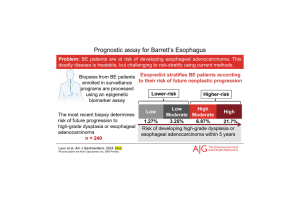
The following was originally published by Johns Hopkins Medicine newsroom.
A novel test developed by Johns Hopkins Kimmel Cancer Center investigators could give gastroenterologists insight into which patients with Barrett’s esophagus — a premalignant condition in which parts of the esophagus become damaged by chronic acid reflux — are likely to progress to esophageal cancer or an abnormal collection of cells called high-grade dysplasia. This information could help physicians determine how to monitor or manage patients during clinical care.
The test, called Esopredict, is a PCR (polymerase chain reaction)-based laboratory test that, from biopsy samples, measures the level of DNA methylation changes in the genes RUNX3, p16, HPP1 and FBN1. Methylation changes often occur early during abnormal cell growth, before conditions can be detected clinically. By combining these results with patients’ age, physicians can gauge the likelihood that patients’ premalignant conditions will advance, and help them determine how often to monitor or manage patients with potential neoplastic progression.
Using the tool in previously collected biopsies from 240 patients with Barrett’s esophagus from six medical centers, researchers determined that the overall risk for neoplastic progression was 5.1%. Patients in the highest risk group had a 21.7% risk of developing high-grade dysplasia or esophageal cancer, compared with a 6.87% risk among those in the high moderate group, a 3.25% risk for those in the low moderate group and just 1.27% among those in the lowest risk group. A description of the work was published online Aug. 14 in The American Journal of Gastroenterology. The test is now commercially available.
“We hope that this test helps clinicians guide surveillance and endoscopic management, so that they can tailor it to the personalized risk of each patient,” says senior study author Stephen Meltzer, M.D., professor of medicine and oncology at the Johns Hopkins University School of Medicine.
About 90% of patients with Barrett’s esophagus typically receive surveillance via endoscopy every three to five years, says Meltzer, director of the GI Early Detection Biomarkers Laboratory. However, that may not be frequent enough to detect some neoplastic changes, he says. Up to 25% of patients who end up developing high-grade dysplasia or esophageal cancer have progressed before their next endoscopy, representing missed opportunities for early intervention. Treatments include radiofrequency ablation or endoscopic resection to remove abnormal cells before they become cancerous.
Clinicians may choose to see patients who have a higher Esopredict score sooner or more frequently.
“Conversely, in people who have a really low score, instead of bringing them back in three years, you might bring them back at a later interval, such as in six or 10 years,” Meltzer says. That modification could decrease health care costs, potential endoscopic complications, lost work productivity and patient anxiety.
Meltzer and colleagues ran the Esopredict test on 209 biopsy samples previously collected from patients with Barrett’s esophagus at Johns Hopkins and Allegheny Health Network, Capital Digestive Health, Mayo Clinic, University of Maryland and University of Connecticut health care sites. The first 99 patient samples served as a training set in which a model algorithm was designed, and the next 110 patient samples were analyzed as a validation set in which the algorithm was tested. Samples also were assayed from an additional group of 31 patients who went on to develop high-grade dysplasia or esophageal cancer and who had follow-up intervals longer than five years.
Some 78 of the 209 patients progressed to having high-grade dysplasia or esophageal cancer within five years of biopsy collection, while the remaining 131 had no progression over the next five years. Investigators ran several calculations with Esopredict to try to predict the likelihood of cancer or high-grade dysplasia developing. They stratified patients into two main groups: lower risk (further refined into low and low-moderate risk categories) or higher risk (further refined into high moderate or high-risk levels) of progressing to more serious conditions. Overall, they found that patients in the two higher risk groups to be 6.4 times more likely to progress to high-grade dysplasia or esophageal cancer within five years. Compared with patients considered lowest-risk, the highest risk patients were 15.2 times more likely to progress to these more serious conditions.
Because most study patients were white (and most patients with Barrett’s esophagus are also white), future studies should include patients of different races and ethnicities, Meltzer says. Ongoing studies are now comparing biopsies from the same patient taken at different times, as well as from different locations in the esophagus taken at the same time, to see whether the risk score changes with location or over time.
Study co-authors were Andrew Kalra, Ke Ma, Hua-Ling Tsai, Hao Wang, Simran Jit, Yulan Cheng, Yousra Ahmed, Kenneth Wang, Cadman Leggett, Ashley Cellini and Olga Ioffe from Johns Hopkins. Other researchers contributing to the work are from Previse in Baltimore (the manufacturer of the Esopredict test); the Allegheny Health Network and its cancer institute in Pittsburgh; Drexel University in Philadelphia; Capital Digestive Care in Chevy Chase, Maryland; Erasmus MC University Medical Center in Rotterdam, Netherlands; and the University of Connecticut.
The study was supported by the National Cancer Institute (grants R44DK136424, R41CA261376, R01DK118250 and R01CA287294). Meltzer is an equity holder in Previse and an inventor of the patented technologies described.